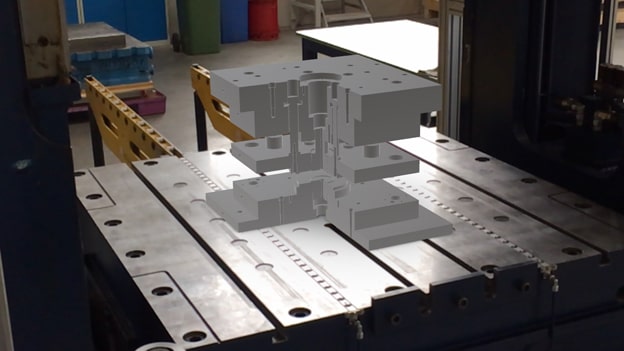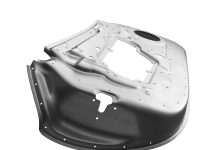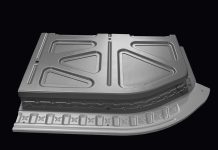In this guest post, Augmented Reality expert Michael Lechner shares feature videos from HOLOneering, demonstrating the use of apps for smartphones and tablets to bring your sheet metal forming simulations even closer to reality. Thank you Michael for this post!
For the efficient manufacturing of components out of sheet metal forming technology is the method of choice, especially for larger lot sizes. Forming technology allows manufacturing of components with best material utilization and with improved mechanical properties. Despite these advantages, forming technology faces big challenges regarding the limited formability of high-strength materials as well as a further reduction of weight.
In recent years, not only the importance of numerical analysis within forming technology but also the possibilities to evaluate the corresponding results increased rapidly as the gap between physical and digital reality decreases. In this context, Augmented Reality offers new ways to integrate numerical analysis into everyday work. Mobile devices enable wide access to simulation results without local limitations. In this way, the results gained on high-performance computers can be shared efficiently throughout single companies or even throughout whole value chains.
Nowadays, mobile phones and tablet computers offer sufficient hard- and software to visualise data as hologram, integrating the data into the physical world. That allows a user-friendly visualisation of simulation results within the production environment.
Groundwork for this solution was the development of an AR-converter for simulation data and a subsequent visualisation of the data on the Microsoft HoloLens. Since Apple launched the current operating system, the application was extended to run on iOS 12 as well. Thereby, no app has to be installed on the device and therefore the holograms can be directly used on every iPhone and iPad.
This approach helps to share and discuss results wherever needed, aiming at a more efficient way of working. The data can be shared via eMail or as a message and then be saved on the mobile device. The reduced amount of data allows the saving of several thousand simulation results on a mobile device enabling a location-independent access to numerical results, as shown in Figure 1. The data can be opened directly from the message or out of a folder and then be displayed as an object on the screen or as a hologram within the environment of the user. The software directly supports AutoForm simulation results.

Figure 1: Augmented Reality with AutoForm simulation results
The extension of virtual models to holograms enables a much easier comparison of those with physical parts than working the other way around by digitising physical parts. Of course, the accuracy of the positioning must be considered. Nevertheless, the technology offers high potential for initial samples and validation. For this purpose, the numerical model is positioned on the physical part allowing an evaluation of the alignment of the outer contours. The intigration of the environment is the major advantage of this technology compared to existing VR-applications. More sophisticated tasks like part measurement still require more sophisticated devivces like the Microsoft HoloLens. The developed software package allows measurement of heights and angles for this device. Furthermore, the user can interact with the hologram via gesture control. However, for basic applications the device has some major drawbacks, such as the high price, the low comfort and the small circulation.
The application for smartphones or tablet computers enables a very efficient and user-friendly access to AR-technology. The conversion of the data allows a rotatable and scalable visualisation of numerical results for everyone everywhere.
Of course, the developed application can also be used to visualize CAD data, as shown in Figure 2. This can help to discuss about the construction or modification of tools as well as a support for quality control for tools or parts with complex shapes or structures. Furthermore, this application is suitable for the designing process of industrial or commercial goods, as it allows an evaluation of proportions without requiring physical models. Furthermore, in contrast to physical models an adaption of the hologram can be made efficiently within a short time and as often as required.

Figure 2: CAD tool design visualised by an Apple iPad
AR-technology offers huge potential for production technology, as there are many use cases and possible fields of application within this field. As the hardware is rapidly developing the potential of applications is also still growing. The solutions presented are constantly making progress to enhance efficiency in the field of forming technology.
Find out more at HOLOneering.com. We specialize in extending the real world with simulation results, measuring data and CAD geometries with Augmented Reality solutions.
* Note: Guest post disclaimer.













